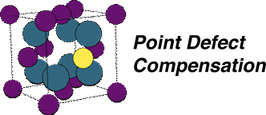
|
 |
|||||
|
|
Introduction
The dissolution of aliovalent solutes requires charge compensation in the solvent phase. For example, consider the dissolution of Al2O3 in MgO: Because Al is trivalent and Mg is divalent, the excess charge associated with the dissolved Al must be compensated by the formation of oppositely charged Mg vacancies. This is an energetically costly process and, therefore, very little alumina will dissolve in magnesia. In fact, it is generally the case that the aliovalent impurities have low solubilities in ceramics. There are, however, interesting and noteworthy exceptions including CaO•ZrO2 and Bi2O3•Nb2O5. In the latter case, Bi2O3 dissolves 22.5 m/o Nb2O5. The goal of this experiment is determine how the excess charge associated with the dissolved pentavalent Nb is compensated in Bi2O3. This problem was originally solved experimentally by Takahashi et al.; the original account of their work can be found at: T. Takahashi, H. Iwahara, and T. Esaka, "High Oxide Ion Conduction in Sintered Oxide of the System Bi2O3-M2O5" J. Electrochem. Soc. 124 [10] (1977) 1563-1569.
|
||||
|
|
|||||